Machine learning unveils hypoxia-immune gene hub for clinical stratification of thyroid-associated ophthalmopathy
- PMID: 40596187
- PMCID: PMC12214582
- DOI: 10.1038/s41598-025-05107-9
Machine learning unveils hypoxia-immune gene hub for clinical stratification of thyroid-associated ophthalmopathy
Abstract
Thyroid-associated ophthalmopathy (TAO) is an autoimmune disorder affecting the orbit, potentially resulting in blindness. This study focused on the role of hypoxia in its pathogenesis through integrative bioinformatics and experimental validation. Five differentially expressed genes associated with hypoxia (HRDEGs) were identified via Gene Expression Omnibus (GEO) database mining: AGO2, CP, DIO3, PSMD14, WTIP. qPCR and immunohistochemistry confirmed reduced expressions of AGO2 and PSMD14, and elevated expression of DIO3 in TAO orbital tissues. Hypoxia exposure aggravated the above dysregulation and promoted proliferation and adipogenesis of orbital fibroblasts. A predictive model was developed using four machine learning algorithms and validated for its effectiveness in diagnosing TAO and assessing disease severity. Functional enrichment revealed hypoxia response, apoptosis, and programmed cell death. Protein-protein interaction and mRNA interaction networks of HRDEGs were established, predicting transcription factors, microRNAs, RNA-binding proteins, and drugs interacting with them. Immune infiltration analysis demonstrated the accumulation of Type 17 T helper cells and CD56 dim natural killer cells in high-risk patients, correlating with DIO3 upregulation and AGO2 downregulation. Flow cytometry confirmed the enrichment of these two cell types in the orbital tissue of TAO. This study revealed hypoxia-immunity crosstalk in TAO pathogenesis, providing a validated predictive model and molecular targets for precision interventions.
Keywords: Hypoxia; Immune microenvironment; Predictive model; Thyroid-associated ophthalmopathy.
© 2025. The Author(s).
Conflict of interest statement
Declarations. Competing interests: The authors declare no competing interests.
Figures

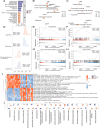
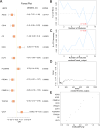

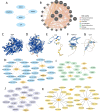

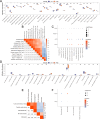
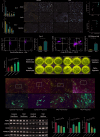
Similar articles
-
Epac1 Inhibits Orbital Fibroblast Activation to Ameliorate Thyroid-Associated Orbitopathy-Like Features Through the JAK/STAT Signaling Pathway.Invest Ophthalmol Vis Sci. 2025 Jul 1;66(9):68. doi: 10.1167/iovs.66.9.68. Invest Ophthalmol Vis Sci. 2025. PMID: 40736178 Free PMC article.
-
Deciphering Shared Gene Signatures and Immune Infiltration Characteristics Between Gestational Diabetes Mellitus and Preeclampsia by Integrated Bioinformatics Analysis and Machine Learning.Reprod Sci. 2025 Jun;32(6):1886-1904. doi: 10.1007/s43032-025-01847-1. Epub 2025 May 15. Reprod Sci. 2025. PMID: 40374866
-
Identification of potential pathogenic genes associated with the comorbidity of rheumatoid arthritis and renal fibrosis using bioinformatics and machine learning.Sci Rep. 2025 Jul 1;15(1):21686. doi: 10.1038/s41598-025-05757-9. Sci Rep. 2025. PMID: 40596265 Free PMC article.
-
Rituximab for thyroid-associated ophthalmopathy.Cochrane Database Syst Rev. 2022 Jun 16;6(6):CD009226. doi: 10.1002/14651858.CD009226.pub3. Cochrane Database Syst Rev. 2022. PMID: 35709102 Free PMC article.
-
Orbital radiation for graves ophthalmopathy: a report by the American Academy of Ophthalmology.Ophthalmology. 2008 Feb;115(2):398-409. doi: 10.1016/j.ophtha.2007.10.028. Ophthalmology. 2008. PMID: 18082885
References
-
- Antonelli, A. et al. Graves’ disease: clinical manifestations, immune pathogenesis (cytokines and chemokines) and therapy. Best Pract. Res. Clin. Endocrinol. Metab.34, 101388. 10.1016/j.beem.2020.101388 (2020). - PubMed
-
- Chin, Y. H. et al. Prevalence of thyroid eye disease in graves’ disease: a meta-analysis and systematic review. Clin. Endocrinol. (Oxf). 93, 363–374. 10.1111/cen.14296 (2020). - PubMed
-
- Bartalena, L. et al. The 2021 European group on graves’ orbitopathy (EUGOGO) clinical practice guidelines for the medical management of graves’ orbitopathy. Eur. J. Endocrinol.185, G43–G67. 10.1530/EJE-21-0479 (2021). - PubMed
-
- Mishra, S. et al. Clinical management and therapeutic strategies for the thyroid-associated ophthalmopathy: current and future perspectives. Curr. Eye Res.45, 1325–1341. 10.1080/02713683.2020.1776331 (2020). - PubMed
MeSH terms
Grants and funding
LinkOut - more resources
Full Text Sources
Research Materials
Miscellaneous

